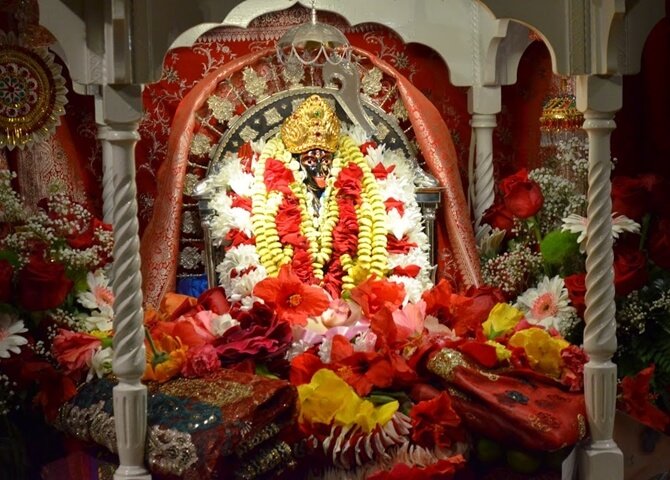Thousands of worshippers visit the temple at Dakshineswar every day, coming from all across the country and even the world. The majestic Dakshineswar Temple, considered one of the most respected temples dedicated to the Goddess, has a rich history that spans religious and social borders. Here is the history and social aspects of Dakshineswar Temple.
The devotion of goddess Kali dates back to the 17th century in Bengal, and the temple is a significant part of that history.
While the main deity of this temple is Goddess Kali, there are 12 tiny Jyotirlingas (Shiva temples) and a Radha Krishna temple situated in a vast courtyard that surrounds the main shrine. There are two bathing ghats for devotees and pilgrims to bathe in the holy river Ganga, which kisses the temple’s perimeter. Kolkata’s navaratna (nine-spired) shrine is an important feature of the city’s architecture and mythology.
Rani Rasmoni, the widow of a wealthy Bengali Zamindar, was planning a trip to Varanasi, India’s spiritual capital, in 1847, according to folklore. It is believed that the night before her departure to Varanasi, Rani had a dream in which Goddess Kali appeared in the shape of Bhabatarini — “She who liberates Her followers from the ocean of existence” — and advised her not to travel to Varanasi. Instead, Rani was told to build a temple and dedicate it to the Goddess and then she setup up Dakshineswar Temple.

The Social Aspects
Apart from spiritual and theological grounds, the Dakshineswar temple was also used as a backdrop for social reforms against evil practises, religious dogmas, orthodoxy, and superstitions that threatened to devour Bengal’s social fabric in the mid-nineteenth century.
Rani Rashmoni is most known as the founder of the Dakshineswar Temple, but it isn’t her only claim to fame. She was one of modern Bengal’s most prominent philanthropists, dedicating her life to the welfare and upliftment of the oppressed masses while also cherishing her motherland. She repeatedly stood up to the British and forced them to back down on policies that were not in the best interests of the people.
Rani Rashmoni’s protest against fishing charges on the Ganga resulted in her stopping the British shipping commerce on the river. She used iron chains to halt river traffic until the authorities removed the taxes.
Rani had to contend with the upper caste Brahmins even with the Dakshineswar Temple. They refused to serve her in the temple because of her non-dominant caste and her beliefs.
Sri Ramakrishna Paramhansa was introduced to her in this way. She had appointed his elder brother, Ramkumar Chattopadhyay, as the chief priest of the Dakshineswar Temple, after whose death, Sri Ramakrishna became the head priest of the temple. Sri Ramakrishna spent the next thirty years of his life at the Dakshineswar Temple, not only performing the function of chief priest, but also immersing himself in deep spiritual practises.
His meditation area is located within the temple grounds and is open to the public during certain hours.
Significance of Dakshineswar Temple
The ancient temple of Dakshineswar holds a particular place in the hearts of Bengalis because it was instrumental in the transformation of Gadadhar Chattopadhyay into Sri Ramakrishna Paramhansa.
Sri Ramakrishna conducted his spiritual austerities, or ‘Sadhanas,’ at this holy shrine to join with the absolute. Sri Ramakrishna is the only saint in India to achieve the ultimate level of spiritual enlightenment, known as ‘Moksha’ or Nirvana, according to Hindus.
The heavenly spot from where Narendranath Datta emerged as Swami Vivekananda — a global spiritual leader who empowered the entire globe in 1893 with his epochal and historic discourse on universal harmony at the World Parliament of Religions in Chicago — is also the Dakshineswar Kali Temple.
With each passing day, the essential ideas of Sri Ramakrishna and Swami Vivekananda’s teachings, such as coexistence of religions, divinity in every living being, and homogeneity of existence, become more apparent.
Dakshineswar Temple Today.
The temple’s appeal hasn’t waned even after so many decades. Instead, the temple’s fame as the site of key social and religious events in Bengal’s history has grown. Every year, 1.4 crore devotees visit the shrine to offer their prayers to the Goddess.
While the temple has mostly stayed unchanged, various modifications have been done to improve worshippers’ experience safer and more comfortable. Increased security measures in and around the temple grounds are one example, as is the Rani Rashmoni Skywalk, a more recent addition.
The state government created the 10.5-meter-wide, 340-meter-long arch-shaped glass and steel skywalk last year on the occasion of Kali Puja at a cost of Rs 60 crore. The elevated roadway, which includes eight staircases, four elevators, and fourteen escalators, connects the Dakshineswar railway station to the temple’s main entrance and allows tourists to ascend and descend at various locations. The skywalk, with its translucent glass walls, adds to the allure of the world-famous temple.
Despite a few modern embellishments, the Dakshineswar Kali temple is steeped in antiquity and retains its old and historic air, where worshippers meet not only to worship Bhabatarini, but also to learn more about her life and teachings. We might hope that the prominence of Dakshineswar Kali temple will stay strong centuries after our existence, given the temple’s fame and belief.













































